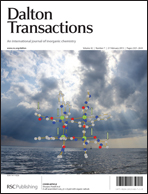Three symmetrical methylene-bis[(aminomethyl)phosphinic acids] bearing different substituents on the central carbon atom, (NH2CH2)PO2H–C(R1)(R2)–PO2H(CH2NH2) where R1 = OH, R2 = Me (H2L1111), R1 = OH, R2 = Ph (H2L2222) and R1,R2 = H (H2L33333), were synthesized. Acid–base and complexing properties of the ligands were studied in solution as well as in the solid state. The ligands show unusually high basicity of the nitrogen atoms (log K1 = 9.5–10, log K2 = 8.5–9) if compared with simple (aminomethyl)phosphinic acids and, consequently, high stability constants of the complexes with studied divalent metal ions. The study showed the important role of the hydroxo group attached to the central carbon atom of the geminal bis(phosphinate) moiety. Deprotonation of the hydroxo group yields the alcoholate anion which tends to play the role of a bridging ligand and induces formation of polynuclear complexes. Solid-state structures of complexes [H2N![[double bond, length as m-dash]](https://www.rsc.org/images/entities/char_e001.gif) C(NH2)2][Cu2(H−1L2222)2]CO3·10H2O and Li2[Co4(H−1L1111)3(OH)]·17.5H2O were determined by X-ray diffraction. The complexes show unexpected geometries forming dinuclear and cubane-like structures, respectively. The dinuclear copper(II) complex contains a bridging μ2-alcoholate group with the −O–P(
C(NH2)2][Cu2(H−1L2222)2]CO3·10H2O and Li2[Co4(H−1L1111)3(OH)]·17.5H2O were determined by X-ray diffraction. The complexes show unexpected geometries forming dinuclear and cubane-like structures, respectively. The dinuclear copper(II) complex contains a bridging μ2-alcoholate group with the −O–P(![[double bond, length as m-dash]](https://www.rsc.org/images/entities/char_e001.gif) O)–CH2–NH2 fragments of each ligand molecule chelated to the different central ion. In the cubane cobalt(II) complex, one μ3-hydroxide and three μ3-alcoholate anions are located in the cube vertices and both phosphinate groups of one ligand molecule are chelating the same cobalt(II) ion while each of its amino groups are bound to different neighbouring metal ions. All such three metal ions are bridged by the alcoholate group of a given ligand.
O)–CH2–NH2 fragments of each ligand molecule chelated to the different central ion. In the cubane cobalt(II) complex, one μ3-hydroxide and three μ3-alcoholate anions are located in the cube vertices and both phosphinate groups of one ligand molecule are chelating the same cobalt(II) ion while each of its amino groups are bound to different neighbouring metal ions. All such three metal ions are bridged by the alcoholate group of a given ligand.
![Graphical abstract: Methylene-bis[(aminomethyl)phosphinic acids]: synthesis, acid–base and coordination properties](/en/Image/Get?imageInfo.ImageType=GA&imageInfo.ImageIdentifier.ManuscriptID=C2DT32045B&imageInfo.ImageIdentifier.Year=2013)
You have access to this article
 Please wait while we load your content...
Something went wrong. Try again?
Please wait while we load your content...
Something went wrong. Try again?
![[double bond, length as m-dash]](https://www.rsc.org/images/entities/char_e001.gif) C(NH2)2][Cu2(H−1L2222)2]CO3·10H2O and Li2[Co4(H−1L1111)3(OH)]·17.5H2O were determined by
C(NH2)2][Cu2(H−1L2222)2]CO3·10H2O and Li2[Co4(H−1L1111)3(OH)]·17.5H2O were determined by ![[double bond, length as m-dash]](https://www.rsc.org/images/entities/char_e001.gif) O)–CH2–NH2 fragments of each
O)–CH2–NH2 fragments of each ![Graphical abstract: Methylene-bis[(aminomethyl)phosphinic acids]: synthesis, acid–base and coordination properties](/en/Image/Get?imageInfo.ImageType=GA&imageInfo.ImageIdentifier.ManuscriptID=C2DT32045B&imageInfo.ImageIdentifier.Year=2013)

 Please wait while we load your content...
Please wait while we load your content...